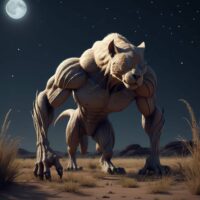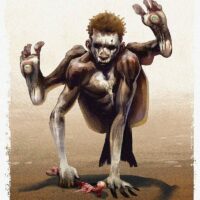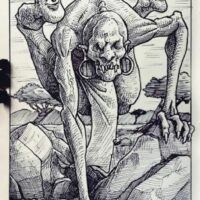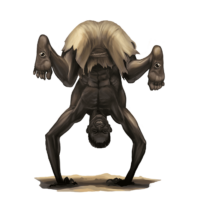Hinn : The Canine Shapeshifter
Listen
At a glance
| Description | |
|---|---|
| Origin | Arabian Mythology |
| Classification | Hybrids |
| Family Members | N/A |
| Region | Saudi Arabia, Yemen, Oman, United Arab Emirates, Jordan, Lebanon, Syria, Iraq |
| Associated With | Shapeshifting, Evil |
Hinn
Introduction
The Hinn are mysterious figures in Arabian mythology, existing on the hazy boundary between pre-Islamic folklore and later Islamic thought. Often mentioned alongside the jinn yet distinct from them, they are regarded as pre-Adamitic beings—creatures who walked the Earth before humanity’s creation. Many traditions link the Hinn to elemental forces, particularly air, and describe them as beings of subtle bodies, capable of astonishing transformations. Their elusive nature, combined with conflicting depictions of them as both harmless and dangerous, has made the Hinn an enduring source of fascination in Middle Eastern storytelling, theological commentary, and oral tradition.
Physical Traits
The Hinn are celebrated in lore for their mastery of shape-shifting. Accounts describe them manifesting as wild dogs, birdlike creatures, or ethereal figures made of wind and mist. In Bedouin tales, they appear as ghostly forms gliding across mountain passes, vanishing before the eye can focus. Some traditions portray them with luminous eyes and feathered wings that catch the moonlight, while others emphasize their invisibility and intangible presence.
Unlike the jinn, who are said to be formed from “smokeless fire,” the Hinn are often believed to originate from samum, a “poisonous fire” described in the Qur’an. This distinction adds a supernatural edge to their association with the wind, as they are said to ride gusts effortlessly, traveling vast distances in moments. Their forms are rarely fixed, and even when appearing in animal or human guise, their movements carry an uncanny fluidity, as though they remain partly air.
Family
The origins of the Hinn connect them to a broader lineage of ancient beings that also includes the Binn, Timm, Rimm, Jann, and Jinn. Islamic scholars and folklorists often place them among the first dwellers of Earth, predating Adam. According to some interpretations, they were among the primordial races whose conflicts and bloodshed caused the angels to question God’s plan to create humankind.
Ibn Kathir’s writings recount how the jinn eventually destroyed the Hinn and Binn, claiming dominion over Earth. The Druze and certain Alawi traditions preserve similar accounts, describing the Hinn as air-born spirits who once held their own kingdoms. In this cosmological framework, each pre-Adamitic race is tied to an element: Hinn with air, Binn with water, Jinn with fire, and humans with earth. This elemental heritage reinforces their perceived role as natural forces, unpredictable and sometimes destructive.
Other names
The word Hinn originates from the Arabic root “hnn,” which means “to yearn” or “to sigh for something.” Over time, it became woven into the intricate web of supernatural classifications found in Arabian and Islamic tradition. In some accounts, the Hinn are described as a type of jinn, while in others they are treated as an entirely separate category of beings. Closely related entities in this mythological framework include the Binn, known as aquatic spirits tied to floods and destructive waters; the Jann, desert-dwelling spirits often linked to whirlwinds; the Shaitaan, rebellious jinn associated with evil whisperings; and the Ghoul, a shape-shifting predator believed to haunt graveyards and desolate landscapes.
These categories are not rigid, and regional variations frequently blur the distinctions between them. Among the Druze, for example, the Hinn are grouped alongside the Binn, Timm, and Rimm, whereas other traditions simply merge them into the broader understanding of the jinn. Such fluidity in classification reflects the nature of oral storytelling, where identities evolve over generations, shaped by local beliefs, cultural exchange, and the shifting boundaries of myth.
Powers and Abilities
The powers of the Hinn are as diverse as their forms. Their most celebrated gift is shape-shifting, allowing them to adopt the guise of animals, humans, or even inanimate objects. Folklore describes their use of illusion to mislead travelers, confuse hunters, or conceal their own movements. As beings tied to air, they are said to command the wind—summoning sudden gusts, conjuring mists, or even redirecting arrows in flight.
Some accounts credit them with the ability to possess living beings, influencing thoughts or emotions in ways subtle enough to be mistaken for one’s own impulses. In certain Islamic traditions, they were counted among the supernatural entities who served the prophet-king Solomon, obeying his commands unlike the rebellious shayatin. Not all depictions cast them as malevolent; in some Bedouin stories, they guard natural places, rewarding respectful behavior while punishing greed or environmental harm.
Modern Day Influence
While the Hinn never achieved the same level of fame as the jinn in popular imagination, they continue to linger in cultural memory. Oral traditions among Bedouin tribes still recount encounters with winged or mist-like beings in remote landscapes. In Islamic popular belief, wild dogs are sometimes approached with caution due to the possibility they may be inhabited by Hinn spirits.
Elements of Hinn lore surface in literature influenced by One Thousand and One Nights, where wind-born spirits or deceptive magical beings echo their traits. In contemporary fantasy fiction, video games, and television, their characteristics—shape-shifting, wind mastery, and moral ambiguity—appear in adapted forms, often merged with other mythical archetypes.
In spiritual and healing contexts, references to entities resembling the Hinn persist in discussions about possession and supernatural illness, especially in regions where belief in jinn remains strong. Modern scholars studying the cultural role of these myths note that such beings serve as metaphors for the unpredictable forces of nature, the dangers of the unknown, and the thin boundary between the physical and unseen worlds.
Related Images
Source
el Zein, A. (2009). Islam, Arabs, and the Intelligent World of the Jinn. Syracuse University Press.
Corbin, H. (2014). Avicenna and the Visionary Recital. Princeton University Press.
Rosenthal, F. (1970). Knowledge Triumphant: The Concept of Knowledge in Medieval Islam. Brill Archive.
Nünlist, T. (2015). Dämonenglaube im Islam. Walter de Gruyter.
Wheeler, B. M. (2002). Prophets in the Quran: An Introduction to the Quran and Muslim Exegesis. A&C Black.
Ibn Kathir. (2014). Early Days: Al Bidayah – Wan Nihayah. Darussalam Publishers.
Horror Chronicles. (2024). Hinn: The Shape-Shifting Demon in Arabian Folklore. Retrieved from https://horrorchronicles.com/hinn/
Occult Sanctum. (2025). The Hinn: The Winged Jinn of the Mountains. Retrieved from https://www.occultsanctum.com/the-hinn-the-winged-jinn-of-the-mountains/
Wikipedia contributors. (2025). Hinn (mythology). Retrieved from https://en.wikipedia.org/wiki/Hinn_(mythology)
Frequently Asked Questions
What is lorem Ipsum?
I am text block. Click edit button to change this text. Lorem ipsum dolor sit amet, consectetur adipiscing elit. Ut elit tellus, luctus nec ullamcorper mattis, pulvinar dapibus leo.
What is lorem Ipsum?
I am text block. Click edit button to change this text. Lorem ipsum dolor sit amet, consectetur adipiscing elit. Ut elit tellus, luctus nec ullamcorper mattis, pulvinar dapibus leo.
What is lorem Ipsum?
I am text block. Click edit button to change this text. Lorem ipsum dolor sit amet, consectetur adipiscing elit. Ut elit tellus, luctus nec ullamcorper mattis, pulvinar dapibus leo.
What is lorem Ipsum?
I am text block. Click edit button to change this text. Lorem ipsum dolor sit amet, consectetur adipiscing elit. Ut elit tellus, luctus nec ullamcorper mattis, pulvinar dapibus leo.
What is lorem Ipsum?
I am text block. Click edit button to change this text. Lorem ipsum dolor sit amet, consectetur adipiscing elit. Ut elit tellus, luctus nec ullamcorper mattis, pulvinar dapibus leo.









